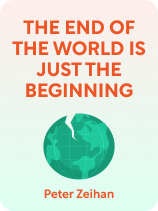

This article is an excerpt from the Shortform book guide to "The End of the World Is Just the Beginning" by Peter Zeihan. Shortform has the world's best summaries and analyses of books you should be reading.
Like this article? Sign up for a free trial here.
What’s the future of global trade? How could a breakdown in international shipping affect your daily life?
Peter Zeihan’s The End of the World Is Just the Beginning presents a sobering view of our globalized world’s fragility. He argues that demographic shifts and geopolitical changes may soon unravel the international trade system we’ve come to rely on.
Keep reading to discover Zeihan’s predictions for the coming decades and learn why he believes some countries are better positioned to weather the storm than others.
Overview of Peter Zeihan’s The End of the World Is Just the Beginning
It’s easy to envision the ways the world might end—nuclear war, mass extinction, and climate disasters may be the first that come to mind. However, according to geopolitical expert Peter Zeihan, the most pressing threat to human civilization is the impending collapse of international trade. Peter Zeihan, in The End of the World Is Just the Beginning (published in 2022), predicts that a looming demographic implosion will trigger a global trade crisis, which the United States may exacerbate if it stops using its military resources to safeguard international shipping.
The end of globalized international trade would spell worldwide economic disaster, causing turmoil and hardships that would be felt by every person on the planet. These would include higher energy costs, political instability, less access to goods and resources, and potential famine in large swaths of the planet. Unfortunately, there may be no way to avoid these problems, and while Zeihan doesn’t offer any clear-cut solutions, he writes that we can’t deal with issues of this scale without being fully aware of what’s at stake.
Zeihan is a geopolitical strategist and consultant known for his expertise in global affairs, demographics, and energy. He’s worked as a geopolitical analyst for various organizations, including the US State Department. Zeihan has written multiple books on global issues, including The Accidental Superpower (2014), The Absent Superpower (2017), and Disunited Nations (2020).
We’ll present Zeihan’s argument that the world has been living in a golden age of international trade since the end of World War II, and why that age of prosperity is about to come to an end. We’ll explain the process by which global trade and interdependence may soon unravel, and what difficulties we can expect to experience in the tumultuous decades to come.
The Golden Age (1945-2020)
Before we can speculate about the end of globalization, we need to define what it entails. According to Zeihan, globalization is the system of free and safe trade between countries, characterized by international economic competition and interdependence on a worldwide scale. Zeihan contrasts this to the prior status quo of empire-building and wars over resources, which climaxed in the first half of the 20th century before the United States changed the paradigm of international commerce.
Throughout history, geography has played a crucial role in determining a country’s survival and stability. This is why the first civilizations emerged in river valleys that were favorable for agriculture, had reliable water sources, and possessed natural defenses against invaders. As technology advanced, we harnessed new energy sources, starting with wind before moving on to coal and then oil. Zeihan explains that the countries that possessed such technological advantages could move their militaries more effectively than their rivals. They conquered their neighbors to acquire more resources, building empires as they did so.
The End of the Old World
Technological progress also increased humanity’s capacity for destruction, culminating in the two World Wars that devastated much of the industrialized world. The US, with its geographic protections and abundant natural resources, emerged from World War II as the only remaining country with a robust economy, a functioning industrial sector, and a strong military. Zeihan says that instead of asserting itself as an empire, the US used its advantage to create a new world order—one aimed at isolating and economically strangling the Soviet Union. The US offered the world a deal: Align against the Soviet Union, and in return, the US would become the world’s police to ensure that international trade could flourish—except in the Soviet bloc.
Zeihan asserts that, during this period, we’ve lived in an era of unprecedented economic growth and stability facilitated by the US’s commitment to protecting worldwide trade and transportation. As a result, many previously undeveloped countries were able to industrialize rapidly and join the global market. These formerly agrarian nations now house a growing number of their people in cities, where power, water, and food must be sourced from elsewhere. To date, that’s been comparatively easy, since for over 70 years, the US Navy has safeguarded global shipping.
International Trade
Zeihan argues that the importance of the US’s commitment to protecting international shipping can’t be overstated. Safe, cheap, and reliable shipping underpins every aspect of globalization, from importing and exporting finished products, to playing a vital role in global supply chains, access to energy, and our ability to feed the Earth’s booming population.
Even before globalization, advances such as deep-water sailing and rail travel changed the limits set on countries by geography. Sailing opened the oceans for international trade, while rail provided easy access to countries’ interiors, letting them ship farm products abroad with relative ease. However, Zeihan writes that, prior to globalization, empires generally didn’t trade with each other—trade flowed between a ruling country and its conquered vassal states while competing empires preyed on each other through the use of state-sponsored piracy. However, when the US changed this paradigm at the end of World War II by agreeing to keep the oceans safe for travel, it effectively rendered the “imperial” model of international trade defunct.
As a result, international trade boomed, with sea ports growing to accommodate the massive volume of cargo they had to handle. Since they didn’t have to defend themselves, ocean-going ships became large and slow, while transportation costs became almost negligible. Safe shipping allowed economies to flourish wherever people could produce and export goods, leading to rapid industrialization and dramatically higher standards of living. Zeihan says an unintended consequence of this system was that different countries could now specialize in producing whatever goods they excelled at, regardless of whether those products met their own citizens’ needs. Instead, they could simply import what they needed and export for profits.
Manufacturing
Zeihan writes that modern shipping has made it possible for countries to specialize not only in producing specific types of products, but also in making specific parts of products, rather than the entire product itself. In this way, globalization has led to a worldwide manufacturing chain where each country serves as a link in the process. Meanwhile, businesses also outsource product design, sales, and distribution to even more countries, locating each task in the part of the world where it can be accomplished at the lowest cost.
While globalized manufacturing makes products and services cheaper for businesses and consumers, this system is inherently brittle. Zeihan points out that long supply chains are extremely vulnerable to natural disasters, political turmoil, and war. If any part of the chain is interfered with, then everyone suffers the impact—suppliers of raw materials can’t reach their markets, those in the middle don’t have products to assemble, and consumers can’t buy the products they need.
Protecting the Oil
Oil is the fuel that runs globalization, and without it, the system won’t function. However, oil is only found in certain locations and must be transported like any other commodity. Before World War II, every country guarded its private oil supply, but afterward, the US opened up the oil trade as part of its efforts to isolate the Soviet Union. Zeihan writes that any non-communist country with oil could enter the business and expect the US to protect its exports. The US’s own dependence on foreign oil gave it further motivation to keep oil traffic flowing, as seen in the first Gulf War. It wasn’t until the advent of “fracking”—drilling for hard-to-reach shale oil—that the US became oil-independent once again, reducing its need to fight for foreign oil.
Feeding the World
Hand-in-hand with advances in trade, globalization has revolutionized agriculture and worldwide food distribution. Industrial farming has increased the productivity of fertile land, which when combined with reliable transportation and refrigeration, has enabled places that previously couldn’t support large populations to do so. It has also allowed cities to expand, as they no longer need to be adjacent to their food supply. Zeihan says that as a result, while hunger still exists, it’s far less prevalent than it would be without globalization.
Global shipping has also let us reorganize where food is grown. Instead of using farms to feed their local communities, most agricultural locations now produce crops that make the most profit and ship them to wherever the demand for them is highest. We now have increasingly specialized agriculture, where countries no longer grow the food they need, but instead grow the food they can sell, expecting that they can import their own food from other farms thousands of miles away. Zeihan warns that while this system provides the world with a level of food diversity never seen before, it relies heavily on safe, reliable shipping. If the shipping network falls apart, so does the distribution of food.
Globalization Falls Apart
All good things come to an end, and according to Zeihan, globalization’s days are just about over. This is because the pillars that support it—cheap energy, low-risk transportation, and stable supply lines for manufacturing and food—are crumbling.
The fall of the Soviet Union marked a turning point for globalization, as the US’s primary reason for maintaining international security disappeared. Although the US hasn’t completely abandoned its role as global protector, it has become increasingly difficult to justify this position to itself and its citizens. While the relaxed global tensions following the Cold War were a boon for most countries—resulting in a free-for-all of worldwide economic expansion—Zeihan argues that this era was the peak of globalization, and its gains aren’t sustainable because of their overdependence on the US ensuring peaceful global trade.
Consider: Many countries are now so heavily specialized in producing particular goods and services for export that most parts of the world can’t provide for themselves if global trade is disrupted. This is Zeihan’s nightmare scenario—that a major blow to international trade will start a chain reaction that topples society on a global scale. Zeihan predicts a sequence of events that will pull the world’s globalized economy apart—the population in key regions will decline, the world will break up into regional factions, and it will become more difficult to transport oil and food where they need to go.
Demographic Collapse
Zeihan suggests that declining populations in the developed world will trigger economic crises around the globe. The process began when more people moved from rural areas into cities—space for families became smaller, birth rates slowly dropped, and medical advances extended people’s lives. The combination of longer lives and fewer children led to our present-day aging population, and though people with fewer children to provide for can increase their savings and investments, boosting the capital fueling economic growth, there are fewer young people to reap the benefits. In short, economic growth isn’t sustainable if the population dwindles, and extended lifespans can only offset a reduction in birth rates for a limited time.
As more people retire from the workforce, there are fewer young workers to replace them, and as the larger, older generation passes away, the precipitous population drop that follows will come as an economic blow to the system. Zeihan argues that China in particular is at the highest risk for a demographic implosion due to its decades-long one-child-per-family policy, and when the Chinese workforce disappears, its economy will crack under the strain. Since China and other East Asian countries are vital to globalized manufacturing, the world will feel the brunt as the number of Asian workers decreases and the cost of their labor goes up.
Zeihan says that only a few countries, including the US, have industrialized and urbanized without seeing a drop in population. While the US will feel a demographic shock as the Baby Boomers (born 1946-1964) retire, the Millennial generation (born 1981-1996) is large enough to potentially carry the country through the 2040s. However, other countries face population reductions that may prove lethal to their economies. In tandem with the workforce reduction, people who retire draw their money out of investments, which decreases the economy’s credit supply, making it harder to fund new enterprises. Moreover, a shrinking labor force also means a smaller tax base, leaving governments strapped for cash to spend on public services.
A Planet Divided
As the world’s population and economy shrinks, the delicate balance of globalized trade will start to come apart at the seams. Zeihan warns that, if the US stops protecting international shipping, then vital trade routes will be vulnerable to local wars and international piracy. Transporting goods will be hazardous again, and the reliable flow of trade between countries could suddenly come to a halt. Zeihan writes that the US is already pulling out of its protective role because the lack of a military threat (such as the Soviet Union posed) and the US’s newfound energy independence make continuing its post-World War II strategies harder to justify internally. However, its policing role is one that no other country is poised to take on.
Because of this, vital shipping lanes throughout the world could become bottlenecks that throttle international trade and production. Zeihan cites East Asia in particular as a significant danger zone—the seas there are some of the world’s busiest shipping corridors, providing crucial links in manufacturing chains, but many East Asian countries are openly hostile to each other. Any outbreak of violence in the region could lead to disaster for all.
No More World Order
If global trade retracts, the world is likely to break apart into regional economies where every commodity is lower in quality and more expensive than it was during globalization. Zeihan speculates that there may even be a return to old-style imperialism, in which stronger countries take over weaker ones to use as sources of goods and cheap labor. However, this approach may prove unworkable in the modern age due to the fact that with declining populations, wealthier countries won’t have enough young people to maintain a conquering army. What Zeihan finds more likely is that powerful countries will set up regional protectorates to safeguard access to the resources they need.
However, as globalization unravels, the countries most dependent on imports and exports will take military action to secure their shipping lanes, which will likely involve measures against their regional rivals. Manufacturing chains will have to become much tighter and more localized than they are today. Zeihan predicts that piracy will resurge, sometimes by criminals, but often by nations desperate to access resources to survive. If that happens, then long-haul, heavy transport may die out, replaced by smaller, local transport vessels designed to outrun potential enemies. Countries with internal waterways, like the US, will fare better than those that are completely reliant on oceanic shipping routes.
Thirsty for Oil
While every commodity will be affected by restrictions on international shipping, those restrictions will compound themselves by limiting access to the resource that makes global transportation possible—oil. If international shipping falls apart, oil production will be drastically reduced, triggering an energy crisis.
The world’s dependence on oil for shipping means that any slight change in supply and demand can have dramatic effects on the cost of other goods. Zeihan anticipates a return to regional oil distribution markets similar to those of the imperial trading networks pre-globalization. Oil supplies will be restricted to whomever oil producers can safely ship it to. The US and Russia, with their internal oil fields, will be the least affected, but most of the world will suffer a severe energy crunch every time its oil deliveries are endangered. Since the US has enough oil for itself at home, it can no longer always be expected to protect the oil trade abroad.
Zeihan reminds us that fossil fuels like oil aren’t just used for transportation—natural gas generates electricity, and petrochemicals are the basis for many material goods, including medical supplies. Although “green” solutions are often proposed, they’re available only in countries with the right geography and climate. Renewable energy generation requires a lot of space and special conditions, and the cost for retooling our entire infrastructure to adapt to renewables is staggering. Renewable energy and substitutes for petrochemicals simply aren’t ready to replace fossil fuels at the scale we need, and the world will feel the coming oil shortages long before we have a viable substitute.
A Hungrier World
Zeihan says that the most serious threat from globalization’s downfall is that people won’t have enough food. The reason for the shortage will be simple—billions of people live thousands of miles from where their food is produced. Feeding them depends on cheap, reliable shipping, and if that fails, so does the food supply. Densely populated cities depend almost entirely on imported food, and if trade breaks down, they can’t feed themselves. One solution may be to move people back to the countryside to work on farms, but many places in the world can’t support enough agriculture to sustain their current population. Therefore, Zeihan predicts that breakdowns in food production will lead to mass starvation, death, and the fall of governments.
However, disruptions to international commerce won’t just stop food from being shipped—farm equipment manufacturers won’t be able to get their machinery to the countries that need it, and if farmers can’t purchase equipment and keep it in working order, they can’t produce food in the first place, with or without a means to ship it. Additionally, Zeihan points out that the technology doesn’t exist to run heavy-duty farm equipment on anything but oil, which—as we’ve already discussed—will also be in short supply. Moreover, oil is a key ingredient in the pesticides that industrial farms use to keep their crops insect-free.
On top of all this, there’s climate change to deal with. Zeihan writes that with changing climate patterns, regions with abundant water and sunlight will become even more productive than before, but dry regions will become even drier, killing any hope of turning them into farmland. In some regions, climate change will alter rainfall patterns, such as by reducing the impact of monsoons that India and Southeast Asia depend on. In places where rainfall increases, frequent flooding will become a problem. The farmlands of the American Midwest may benefit from climate change and increase their yield, but overall, Zeihan says that the regions that increase their food production won’t offset the loss of arable farmland elsewhere in the world.
The Shape of Things to Come
Though the problems coming our way may be unpleasant to think about, finding a way through them is even more difficult. Zeihan attempts to do so by focusing on the most basic needs that nations have to fulfill, including acquiring enough resources and food to keep people going through the lean times ahead.
Zeihan argues that, of all the world’s countries, the US is uniquely positioned to weather the storms of deglobalization. The US has more high-quality farmland than any other country, which will serve it well in the trying times to come. Thanks to fracking technology that lets the US drill for shale oil, as well as an abundance of land that’s ideal for solar and wind power, the US has lower energy prices than any other country. Moreover, thanks to the geographic barriers of two oceans and its strong economic ties with its only two neighbors (Canada and Mexico), the US is essentially invasion-proof against other rival states that may envy its resources.
Extreme Resource Management
Zeihan writes that many of the assumptions the modern world rests on won’t apply any longer in the near future. Chief among these is the belief that vital resources can be imported from anywhere else in the world at little cost. In the future, countries will struggle to maintain their supply lines, with varying degrees of success, and while the US and its neighbors may be able to do so, other countries—particularly China—may find themselves in serious trouble.
In a deglobalized world, countries will have to find new ways to obtain and manage the resources they need. Those blessed with the right geography and climate may be able to fuel and feed themselves internally, while others might survive by using their highly skilled knowledge base to export expertise instead of physical goods. However, Zeihan insists that supply and manufacturing chains will have to be local. Some countries may lose their industrial base entirely, with potentially disastrous humanitarian consequences.
West Versus East
Zeihan suggests that the North American Free Trade Agreement (NAFTA) may prove to be the Western Hemisphere’s saving grace. In terms of food, manufacturing, and raw materials, the Americas (both North and South) can survive as a fairly self-contained system. Between them, the US and Mexico have an outstanding capacity for renewable energy generation, and their relatively stable demographics will soften the blow of the population plunge that Zeihan expects to shake the rest of the world. The key will be for the US, Mexico, and Canada to establish even stronger economic and demographic ties, while reestablishing the robust manufacturing base that the US let slide during the years of globalization.
On the other hand, Zeihan firmly believes that China faces a catastrophic collapse. At present, China is financially overextended, is entirely reliant on globalized trade, and is about to go through a demographic meltdown. If globalized trade ceases to function, and China can’t import enough energy, food, or manufacturing resources, its economic and industrial foundations will shatter, and its people will suffer. China’s downfall will cascade into major economic crises throughout the world, but it may also create opportunities for still-developing countries to establish themselves as centers of manufacturing and commerce.
Feeding the World to Come
Sadly, manufacturing and economic worries may pale in comparison to the main danger that the end of globalization represents—that there might not be enough food to go around. Zeihan explores some options countries might take to secure enough food, though some of them aren’t pleasant, such as ceding control to wealthier nations or taking a giant leap back to the days of agrarian, subsistence farming.
As international trade unravels, how well countries can feed their people will determine how much chaos and human misery they’ll experience. According to Zeihan, only a handful of countries are capable of being completely self-supporting. Those that can’t grow the food they need will either go hungry or risk becoming vassals to any agricultural superpower that’s able and willing to feed them. No matter what, too many populations have grown beyond what local agriculture can support, and in the worst-case scenario, billions of people will face famine and starvation. There’s hope in new technologies, including AI-based crop management, but Zeihan thinks it’s unlikely that massive agricultural breakthroughs will happen soon enough.
Another option we mentioned earlier is to force people out of their cities and back to working on farms. Zeihan writes that the days of specialized agriculture will end, since countries will have to go back to the basic staples they need to feed their own people. While this may help some countries survive, they’ll be much poorer than they are today because they won’t be growing the cash crops that are profitable under globalization. Wealthier countries will feel the pinch in the form of fewer options in grocery stores, but for poor countries, the result will be a rollback to subsistence farming.
Finding the Future
If Zeihan’s forecasts for the future seem bleak, that’s because they are. The old rules of government, society, and trade will no longer work in the post-globalized era, and our transition into the future will be bumpy. Zeihan makes some guesses about what the post-globalized world will be like—countries and people will make do with less, old alliances will reshuffle, and new solutions to old problems will emerge.
As the world moves away from globalization, we’re about to enter a time of vast upheaval, and what political and economic realities may emerge once the turmoil is over remains uncertain. If the US holds its own, as Zeihan predicts, we can expect many people from all over the world to want to immigrate. Unfortunately, no matter which nations are best at adapting to the world’s new conditions, everyone will have to figure out how to get by using fewer resources. The world of the future will likely be defined by fractured alliances and lower standards of living, while national economies will simply have to cope with a smaller workforce than before.
However, Zeihan is hopeful that the pains of shifting to new world realities won’t mean the end of civilization. While the 2020s and ’30s won’t be pleasant, Zeihan believes that by the 2040s, we’ll have achieved a new global equilibrium for agriculture and trade. Given the history of technological progress, he has no doubt that new solutions will arise to solve many of the oncoming problems, especially for energy generation and food production. Nevertheless, the inequalities between the countries that do well to survive and those that don’t will be stark. Whatever happens, Zeihan says that our Golden Age of cheap trade and international interdependence will be over.

———End of Preview———
Like what you just read? Read the rest of the world's best book summary and analysis of Peter Zeihan's "The End of the World Is Just the Beginning" at Shortform.
Here's what you'll find in our full The End of the World Is Just the Beginning summary:
- Why the golden age of international trade is about to end
- Why the collapse of international trade is the biggest threat to civilization
- How to prepare for tumultuous decades to come






